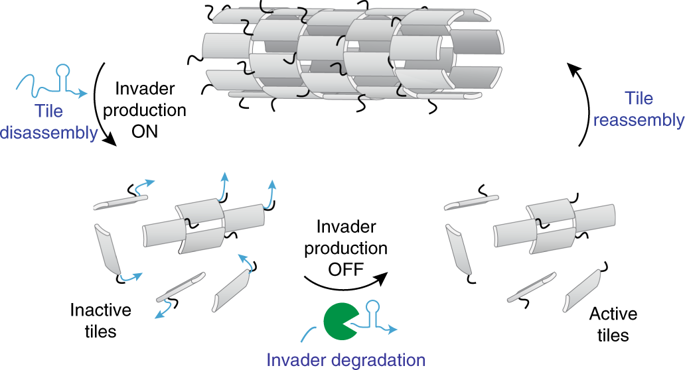Nature Chemistry ( IF 19.2 ) Pub Date : 2019-04-22 , DOI: 10.1038/s41557-019-0251-8 Leopold N. Green , Hari K. K. Subramanian , Vahid Mardanlou , Jongmin Kim , Rizal F. Hariadi , Elisa Franco

|
Biological cells routinely reconfigure their shape using dynamic signalling and regulatory networks that direct self-assembly processes in time and space, through molecular components that sense, process and transmit information from the environment. A similar strategy could be used to enable life-like behaviours in synthetic materials. Nucleic acid nanotechnology offers a promising route towards this goal through a variety of sensors, logic and dynamic components and self-assembling structures. Here, by harnessing both dynamic and structural DNA nanotechnology, we demonstrate dynamic control of the self-assembly of DNA nanotubes—a well-known class of programmable DNA nanostructures. Nanotube assembly and disassembly is controlled with minimal synthetic gene systems, including an autonomous molecular oscillator. We use a coarse-grained computational model to capture nanotube length distribution dynamics in response to inputs from nucleic acid circuits. We hope that these results may find use for the development of responsive nucleic acid materials, with potential applications in biomaterials science, nanofabrication and drug delivery.
中文翻译:

DNA纳米结构自组装的自主动态控制
生物细胞通常使用动态信号和调节网络来重新配置其形状,该网络通过感知,处理和传输来自环境的信息的分子成分在时间和空间上指导自组装过程。可以使用类似的策略在合成材料中实现栩栩如生的行为。核酸纳米技术通过各种传感器,逻辑和动态组件以及自组装结构,为实现该目标提供了一条有希望的途径。在这里,通过利用动态和结构DNA纳米技术,我们演示了对DNA纳米管自组装的动态控制-众所周知的一类可编程DNA纳米结构。纳米管的组装和拆卸可通过最少的合成基因系统(包括自主的分子振荡器)进行控制。我们使用粗粒度计算模型来捕获响应于核酸电路输入的纳米管长度分布动态。我们希望这些结果可以用于响应性核酸材料的开发,并在生物材料科学,纳米制造和药物输送中具有潜在的应用。































 京公网安备 11010802027423号
京公网安备 11010802027423号